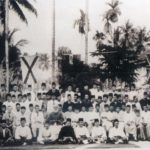| Rajindar Singh Bedi | ||||
|
The earliest arrival of Sikhs is always associated with the police force, especially the police recruits of Captain Speedy (1870). This is, however, not true. The first Sikhs to arrive in Malaya were political prisoners from the Punjab. These were officers and men of the army of the annexed Punjab, captured by the British after the second Punjab war of 1848. These men were deemed dangerous to the East India Company rule in Punjab. Penang and Singapore were designated penal colonies for prisoners from India serving sentences of more than 7 years. The most famous prisoner was Maharaj Singh who died in solitary confinement in Outram Road Prison in Singapore in 1856. He was cremated in the grounds opposite the prison where the Singapore General Hospital exists today. A memorial shrine was built at that spot in later years by Sikhs as they came to know of this incident. The shrine has been shifted to the Gurdwara that stands in front of the Hospital today. Incidentally the Gurdwara was built by the Sikh Contingent of the Straits Settlements Police. His assistant, Kharak Singh was transferred to Penang Prison in 1857 after rumors circulated among the prisoners that Kharak Singh was planning an uprising in the prison. The last known Sikh prisoner from India died in Penang in 1903. According to Mr. Malkiat Singh Lopo in his book, “Some Historical Notes”, in 1903 the Home Surgeon of Penang wrote, “there still remained alive one Sikh convict over 100 years old”. This prisoner was looked after by men of the Malay States Guides stationed in Sepoy Lines Penang. He is said to have been brought to Penang when he was in his 20’s, and this would mean that he arrived in the 1820’s to 1830’s. The day before he died there was a fierce tropical storm and one of the Angsana trees located near the prison was uprooted. The old man said that he had helped plant that tree when he was young and now it had fallen, his end was near. The next day he died. The Police Force Captain Speedy brought in his Sikhs into Larut to stop the fighting between the Ghee Hin and Hai San societies in the 1870’s. By the 1890’s, Sikhs were employed in the police forces of all Malay States and also British North Borneo and Sarawak. A couple of interesting Police General Orders were issued during that period to help maintain the identity of these Sikh men. Among them were General Order No 12 of 1890, which prohibited Sikh Police men from cutting or trimming their hair and beards, and General Order 378 provided for the supply of Charpoys (Punjabi Beds) for the men and their families. The 1909 Kedah annual report mentioned that there were 154 Sikh men in the Kedah Police out of a total strength of 501 men. An amusing incident happened that year. The Kedah Government bought 100 Gruys rifles from France. These rifles were 4 feet 3 inches long. While these rifles were issued to the Sikh policemen, they had to be withdrawn from the Malay members of the Police and the shorter SNIDER carbines were issued to them. The Sikh Contingent of the Straits Settlements Police were used only for guard and escort duty or during riots as the Sikh police was used in “Tau Chang” troubles of 1912 in Malaya. Penang Sikhs Penang Harbor Board Other Occupations In the days before refrigeration, the diary industry was controlled by the Sikhs who supplied fresh milk. There was one Hazura Singh of Alor Star who passed away in 1998 in Butterworth at the age of 98. He told me that he used to send fresh milk to the Palace in Alor Star in the early 1920’s and personally knew Sultan Abdul Hamid. In Penang we had Mall Singh of Bayan Lepas who supplied milk until the early sixties. In Province Wellesley there were also a number of milkmen such as Pratap Singh who would cycle down from places as far as Sungei Bakap and Juru and then cross over by ferry to Georgetown to deliver fresh milk to Punjabi and other Indian houses. Many merchants came down to open shops and start businesses. These people traded in textiles and provisions. Watchmen (Jagas) Gurdwaras (Houses of Worship) There was a growing need for a place of worship for the local Sikh population and also for migrants to Malaya for whom Penang was the first stop. Most of the migrants stayed on the five-foot ways of shop houses. One favorite place for newcomers to convey was a piece of open ground where the present Chinese Town hall is located in Pitt Street. The local Sikh community and the Malay States Guides managed to get a piece of land in Brick Kiln Road from the Government. A Gurdwara was built on this spot in 1901 and is known as the Diamond Jubilee Gurdwara. The story of this Gurdwara came to be built and the opening ceremony has been written by Mr. Natha Singh, a retired lawyer. Incidentally this gentleman was also a Police Inspector in the Straits Settlements police force before he took up law studies. There are now five Gurdwaras in the State of Penang, three on the island and one each in Butterworth and Prai. Conclusion |
||||
